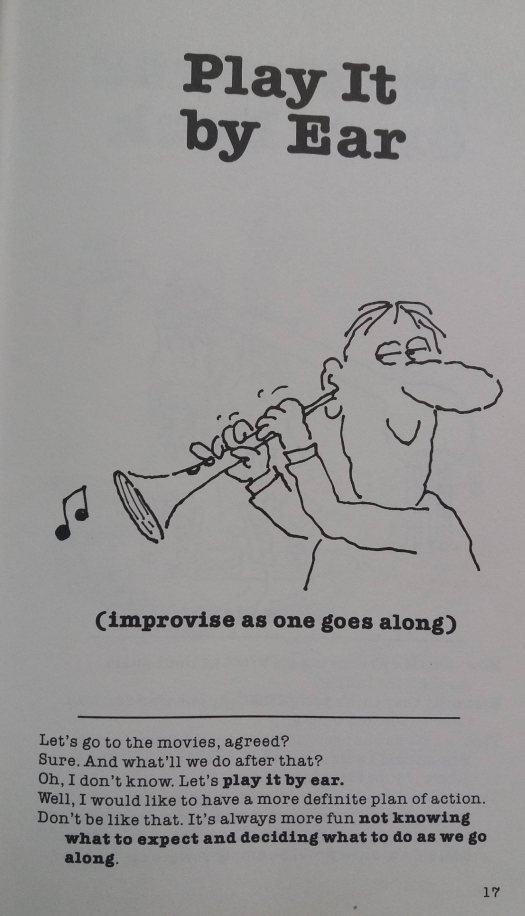Learning English Idioms for Fun
Fuqin Pan, China
Fuqin Pan is a senior lecturer in English language teaching in China. She holds interests in adapting authentic English materials to daily teaching. She has taught intensive reading, advanced English listening and speaking to college students in China. Currently, she is teaching English documents reading to finance-majored postgraduate students in Renmin University of China-Suzhou Campus.
E-mail: pfq_sky2001@126.com

Menu
Introduction
Inspirations and resources
Having fun step by step
Conclusion
References
When teaching English and observing English lessons in different Chinese colleges and universities in the past decade, I found that few of them had specific courses for teaching English idioms, yet, many teachers would introduce the definition and examples of English idioms in either speaking, listening, reading or writing lessons, even in translation lessons for learners’ better understanding of target language points. English idioms are widely used by native speakers both in oral and written works, which can be attributed to idioms’ natural bond with cultures in main English-speaking countries. Saeed (2003) defined an idiom as a collocation of words commonly used in a group and changes definition of each of the words that exists. Idioms don’t let out their meanings literally; people from other cultures can only understand the fixed array of words by learning, either the origin of an individual idiom, or the usages of the idiom by people in the culture. Understanding some commonly used idioms and using them appropriately will surely benefit English learners in their communications with native speakers and make their language more native-like. While living in the target culture to experience the wide use of idioms is not always realistic, a need to learn them comes into being, yet not necessarily outside the culture! However, many teachers (Wu and Cui 2008; TăRCăOANU, 2012; Fotovatnia and Goudarzi, 2014; Alrishan and Smadi, 2015) found teaching and learning English idioms in an EFL context is difficult, especially when it comes to translate English idioms to the mother tongues. In my eyes, only thorough understanding of idioms can help effective translation; here, I’d like to share with other English teachers in the world my own experience in setting up an elective course named “Learning English Idioms for Fun”.
I luckily received a book as a gift from my mentor Marita Downes at the second year of my teaching career in 2004. The book “101 American English Idioms” by Harry Collis immediately caught my interests. On each page, one piece of idiom goes with a cartoon illustration and a simple but accurate paraphrase in brackets under the picture; at the bottom there is an example sentence with both the idiom and the explanation in bold font (Figure 1). I read the whole book and experimentally used some of them when communicating with native English teachers. For example, when we were talking about the confidentiality issue of final exams, I applied “never let the cat out of the bag”; when preparing the New Year English Drama Show for a long day, I said to my colleagues and students: “hit the hay tonight and embrace a new day tomorrow”. Gradually, people around me noticed my change and awarded me a title as “the queen of idioms”. Over the past 10 years, I keep using idioms in my lesson instructions, in my emails with students, in my chat with foreign friends, in my written comments on students’ assignments, etc. Not only students but also teachers should learn by doing, which keeps reminding us of the merits of learning. We are using what we have learnt and we are having fun!

(Figure1:101American English Idioms, 1987, p7)
In 2011, I found a special idiom program “The Teacher” on BBC Learning English when making an English idioms portfolio for future teaching. The teacher-Pete Staves
helped lots of English learners in the world by making creative and humorous videos to explain and set example of English idioms in series. Due to his great contributions, he won English Speaking Union President's Award 2007 and collected the award from The Duke of Edinburgh. Humorous as he was, Pete made this award-winning experience into another idiom learning video! After six themed series of around 40 videos on animal, food, body, color, sport and transport as well as several specials, The Teacher as an English idioms teaching program has stopped updating since 2013, yet all the videos have been archived and still can be downloaded from:
www.bbc.co.uk/worldservice/learningenglish/language/theteacher/index.shtml
With the collections of idioms resources since 2004 and the new discovery of “The Teacher”, I decided to open up an elective course for those who want to have fun in learning English!
Step 1: Watch “The Teacher” video and laugh! Pete Staves -- the only actor always starts with: Hello, I am a very interesting and intelligent man….” He is performing to explain each idiom in a humorous and exaggerating way, making people laugh and never feel tired in learning English. Take pie idiom for example, when teaching “as easy as pie”, the actor eats a big pie very quickly to show that eating a pie is very easy. In a funny way he drinks five mugs of beer, a full mug in a lump, and then he pretends to be drunk. He put two pies on his eyes like a big pair of glasses and begins punch-drunk walk (Figure 2). It can not be clearer to see that the idiom “pie-eyed” just means very drunk. Thanks to the diversities in the program with on-the-spot drawing, pictures, special sound effect, borrowed video clips, etc., understanding is as easy as pie. Remember: Play the whole video with no pause and no loss.

(Figure 2: The Teacher: Pie)
Step 2: Elicit the three idioms in each video as well as their English meanings. Please adopt different methods according to the language levels of your students. For elementary learners, you’d better design a matching task with the three sets of idioms and meanings; for intermediate learners, pictures related to these idioms are enough to help them recall the necessary content in the video. It’s better not to correct any grammatical errors in students’ output but to encourage them as long as they form a right awareness of the topic and get a rough idea of each idiom and its meaning.
Step 3: Replay the video and pause when each meaning group is completed. Get your students’ attention to the teacher’s talk pace, word stress, sentence stress and body language. While pause, leave one minute or two for students to work in pairs and repeat the meaning group, trying their best to keep the original pace, intonation and volume. Then, encourage volunteers to present the sentence in The Teacher’s way. We had so much fun when volunteers imitated hiccups or used one shoe as a receiver to answer a phone call. After appreciating the necklace in former steps, we need to admire the beauty of each pearl linking the necklace. Seizing the opportunity, I am taking down a few difficult words and sentence patterns on the board to emphasize language forms. However, the priority in the step is to enjoy sound of English!
Step 4: In practice, I found some students still have difficulty in separating one idiom from another one due to weak listening ability. It is necessary to confirm the three idioms and their respective meanings with students by designing exercises such as filling the blanks, matching pictures with appropriate idioms, teacher-students pair to say idioms to elicit meanings, or say meanings to elicit idioms. The basis mode is like this: In English, if you want someone who’s __________ to _________, you can say “keep your hair on”. or In English, if we're very anxious about something we can say “_____________.”(Answers: angry; calm down; I’m tearing my hair out.)
Step 5: We language teachers know that in one lesson, there should be a balance between input and output proportion. Learners need time to absorb what they have received and digest to transform new knowledge into their own asset. A chance for them to output their asset and share with others will bring a sense of achievement, so to motivate sustainable learning. The Teacher surely knows about this and he opened up space on the website for learners all over the world to post their creative sentences using the three idioms in each video. Some learners made separate sentences to practice using idioms one by one; others created a complete meaning group containing all the three idioms in one coherent context; for example: “The beautiful lady won the contest. Of course it was time to go bananas for her. But as a Miss. Universe she was very earnest. On the other side, for her rivals it was such a case of sour grapes. Everyone was wishing to have a second bite of the cherry” (Dilek, Istanbul, Turkey: Fruit in Food series). Show both types of examples to students and encourage them to create their own context using three idioms under the same topic. Believe me: your students will surprise you with their creativities. Most of my students tried to put three idioms in one context, here is an example: “I often spilled the beans after drinking a lot because of being full of beans, but I still have a group of friends who like to share with me together and will never leave me alone even if I haven’t got a bean” (by Luo, L. in 2011 Elective Course). Expanding your lessons internationally is possible with the help of advanced information technology and globalised vision of you as a facilitator in class.
Step 6: This last step is quite a challenge. You can only move to it after you have finished all the five steps above and do have some time left for students to make it happen. For the elective course, I keep it as one assignment for final assessment. Each time, when we finished one series, such as the body idioms of The Teacher program, I would add more idioms on the same theme which had been collected from other sources, such as get off someone’s back, all thumbs and play it by ear. For each new added body idiom, I would give them an example sentence (Figure 3.). Students were suggested to keep a portfolio of these added idioms including the given examples and their own creation to use them. When we had several minutes left in class, students would exchange their portfolios with each other, doing peer evaluation towards their works. They would come to me if questions or confusions occurred. At the second half of the course, I encouraged them to pick three added idioms from their collection and make a video just as The Teacher did, presenting the idioms as well as meanings in various forms including language, actions and pictures. It’s OK if they need a partner to appear in the video to assist performance. The basic requirement was to clearly introduce three English idioms with meanings and examples. With a whole semester’s learning and practice of The Teacher program, making one was rewarding to test learning effects but also challenging to realize creative ideas and qualified language ability. Remember to make a checklist for the video, so your students will know to which directions they should go.

(Figure 3: 101American English Idioms, 1987, p17)
The six steps are actively involved in the elective course Leaning English Idioms for Fun. Each topic has been supplemented with a PowerPoint, which contains topic-related pictures, cartoons, video links, exercises and model sentences. Shu, one of the students in the elective course, once created a context for Tea topic and won big applauses from the whole class: Chocolate is most people’s cup of tea. But some people who want to lose weight wouldn’t eat it for all the tea in China. And they will go on a diet or take slimming products instead of exercise. This is as good as a chocolate teapot. Because it’s harmful to health and once you stop using it, it will rebound. At the end of the course, a questionnaire was made for all the thirty participants to give feedbacks to the course. Eight questions were listed in the questionnaire asking about this course from various aspects, such as: why do you choose this course? Can you explain the definition of idiom after learning this course? What is the most difficult part for you in this course (listening, sentence making, understanding idioms under different cultures, etc.)?Which topic impresses you most? Which part of the course do you like best (BBC short videos, lecturer’s PPT, model sentences, listening repeat practice, vocabulary, cultural knowledge, communicative skills with others, etc.)? Are you going to learn more English idioms from now on? The feedback analysis showed that most students chose the elective course because they were interested in English and wanted to improve it. This motivation kept the whole course alive and fully attended. However, though the definition of idiom has been explained in the first lesson, many students still had confusions between idioms and proverbs due to the close relations of the two in Chinese language. More than half participants chose listening as the most difficult part for them and claimed that repeating practice helped them with the listening. Pie, Tea and Fish were listed as three most impressive idiom topics among all the participants. Twenty three out of thirty students chose BBC short videos as their favorite part of the course, followed by model sentences around the world and the lecturer’s PPT next. Two thirds participants said they would learn more English idioms in the future.
This is an interesting experience to use BBC learning English resources in EFL classes and see students have fun during the learning process. The combination of appropriate online resources and learner-based teaching plan can really make teaching and learning easy and rewarding. I hope it will work well in your class and look forward to hearing from you to share your experience with me.
Alrishan, A. & Smadi, O. (2015). Difficulties EFL Jordanian University Students Encounter in Translating English Idioms into Arabic. Journal of Education and Practice, 6 (10), 124-133.
Collis, H. & Risso, M. (1987). 101 American English Idioms. Lincolnwood (Chicago), Illinois: Passport Books.
Fotovatnia, Z. & Goudarzi, M. (2014). Idiom Comprehension in English as a Foreign Language: Analysability in Focus. In Proceedings of the International Conference on Current Trends in ELT, Procedia - Social and Behavioral Sciences 6 May 2014 98:499-503.
http://www.bbc.co.uk/worldservice/learningenglish/aboutus/2009/02/090209_about_award_esu07.shtml
Pete, S. (2007) Video on the English Speaking Union President's Award 2007.
Saeed, J. I. (2003). Semantics. 2nd edition. Oxford: Blackwell.
TăRCăOANU, M. C. (2012). Teaching and Learning Idioms in English (Theoretical and Practical Considerations). Scientific Journal of Humanistic Studies. 4 (7), 220-228.
Wu, L. & Cui, H. D. (2008). Conceptual Metaphors and the Teaching/Learning of English Idioms: An Experimental Study. Heilongjiang Researches on Higher Education. 7, 170-173.

Please check the English Improvement course at Pilgrims website.
Please check the Methodology & Language for Secondary course at Pilgrims website.
Please check the Teaching Advanced Students course at Pilgrims website.


|